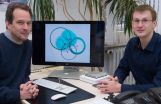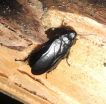New challenges for ocean acidification research
Experts look back at a successful decade and carve out future priorities
2014-12-19
(Press-News.org) Over the past decade, ocean acidification has received growing recognition not only in the scientific area. Decision-makers, stakeholders, and the general public are becoming increasingly aware of "the other carbon dioxide problem". It is time to reflect on the successes and deficiencies of ocean acidification research and to take a look forward at the challenges the fastest growing field of marine science is facing. In the January issue of the journal Nature Climate Change Ulf Riebesell, professor for Biological Oceanography at GEOMAR Helmholtz Centre for Ocean Research Kiel, and Jean-Pierre Gattuso from the French Centre National de la Recherche Scientifique (CNRS) urge the international scientific community to undertake a concerted interdisciplinary effort. According to the two experts, future ocean acidification research will have to deal with three major challenges: It needs to expand from single to multiple drivers, from single species to communities and ecosystems, and from evaluating acclimation to understanding adaptation. "The growing knowledge in each of the diverging research branches needs to be assimilated into an integrated assessment", Prof. Riebesell points out.
For the scientific community, it is obvious that ocean acidification does not occur in isolation. Rising temperatures, loss of oxygen, eutrophication, pollution and other drivers happen simultaneously and interact to influence the development of marine organisms and communities. "The effects can be additive, synergistic or antagonistic and it is generally not possible to extrapolate from single- to multiple-driver responses", Prof. Riebesell explains. "But with an increasing number of parameters, experiments become increasingly challenging in terms of time, space and costs. Also, it becomes ever more difficult to compare and verify results of similar studies."
There is now an impressive body of scientific literature on how individual species react to ocean acidification as a single driver. Many calcifying organisms such as corals, mussels or snails will find it more and more difficult to build their shells and skeletons. The extra energy needed for calcification will be lacking for other biological processes, such as growth or reproduction. „But an open question is to what extent results from short-term, single-driver laboratory experiments can be extrapolated to the real world", Dr. Gattuso states.
As shown in laboratory experiments, evolutionary adaptation to ocean acidification is possible. The larger the population size of a species and the shorter its generation time is, the higher the chances are that it can adapt to new environmental conditions through selection or mutation. "But can adaptation keep up with the fast changes we are experiencing today? Are the organisms able to maintain their functions within the changing ecosystem," Dr. Gattuso wonders.
To make further significant progress in the future, ocean acidification research has to integrate the knowledge gained in its three diverging branches - addressing multiple stress factors, competitive and trophic interactions, and adaptation through evolution. "This requires an interdisciplinary effort, for example through long-term experiments that examine the effects of multiple drivers over many generations at the community level. "Experiments have to be tightly integrated with field studies and model simulations", Prof. Riebesell recommends. "A key factor in this process will be that funding opportunities are opened up for large-scale integrative projects, long-term monitoring and international collaborations." Now that a basic understanding of ocean acidification impacts is developing, it is critical to pay special attention to aspects relevant for society. "This will then pave the way to develop management options and provide science-based policy advice."
INFORMATION:
Original Publication
Riebesell, U., Gattuso, J.-P. (2015) Lessons learned from ocean acidification research. Reflection on the rapidly growing field of ocean acidification research highlights priorities for future research on the changing ocean. Nature Climate Change 5, 12-14 (2015), doi: 10.1038/nclimate2456
Background
Ocean acidification and the BIOACID project
The oceans absorb about one-fourth of the carbon dioxide (CO2) produced by humans. As a result of this, the amount of this greenhouse gas remaining in the atmosphere is reduced and global warming progressing slower. This service, however, comes at a price for the ocean as the CO2 reacts with seawater to form carbonic acid - a process called ocean acidification. This can have adverse effects on marine organisms and ecosystems and may impact food webs and biogeochemical cycles. In the framework of BIOACID (Biological Impacts of Ocean Acidification), the German research network coordinated by GEOMAR Helmholtz Centre for Ocean Research Kiel, 14 institutions examine how marine life reacts to ocean acidification, how this affects marine food production and the exchange of material and energy in the ocean as well as the consequences for ecosystem services. A list of member institutions, information on the scientific programme and the BIOACID committees and facts about ocean acidification can be found on the website http://www.bioacid.de.
Links
http://www.bioacid.de BIOACID (Biological Impacts of Ocean Acidification)
https://oceanacidification.files.wordpress.com/2014/10/gattuso_etal_2014b1.pdf Intergovernmental Panel on Climate Change (IPCC) box on ocean acidification
http://www.igbp.net/publications/summariesforpolicymakers/summariesforpolicymakers/oceanacidificationsummaryforpolicymakers2013.html Ocean Acidification Summary for Policymakers
http://www.iaea.org/ocean-acidification Ocean Acidification International Coordination Centre (OA-ICC)
http://www.geomar.de GEOMAR Helmholtz Centre for Ocean Research Kiel
http://www.lov.obs-vlfr.fr/en/index.html Villefranche Oceanographic Laboratory
Images
Images are available for download at http://www.geomar.de/n2230-e. Video footage on request.
Contact
Prof. Dr. Ulf Riebesell
GEOMAR, RD2-BI
Tel.: +49(0)431 600-4444
uriebesell@geomar.de
Maike Nicolai
GEOMAR Communication & Media
Tel.: +49(0)431 600-2807,
mnicolai@geomar.de
ELSE PRESS RELEASES FROM THIS DATE:
2014-12-19
Bremerhaven/Germany, 18 December 2014. Ingestion of microplastic particles does not mechanically affect marine isopods. This was the result of a study by biologists at the North Sea Office of the Alfred Wegener Institute, Helmholtz Centre for Polar and Marine Research (AWI) that was published recently in the journal Environmental Science and Technology. The study marks the launch of a series of investigations aimed at forming a risk matrix on the sensitivity of different marine species to microplastic pollution.
Uptake of large plastic items by birds and fish may cause ...
2014-12-19
In a recent study from Lund University in Sweden, researchers have used new technology to study extremely fast processes in solar cells. The research results form a concrete step towards more efficient solar cells.
The upper limit for the efficiency of normal solar cells is around 33 per cent. However, researchers now see a possibility to raise that limit to over 40 per cent, thereby significantly improving the potential of this energy source.
The experiments in the present study involved 'juggling' on quantum level with photons, i.e. light particles, and electrons. ...
2014-12-19
In everyday life, the global positioning system (GPS) can be employed to reliably determine the momentary location of one en route to the desired destination. Scientists from the Institute of Physical and Theoretical Chemistry of the University of Bonn have now developed a molecular "GPS" with which the whereabouts of metal ions in enzymes can be reliably determined. Such ions play important roles in all corners of metabolism and synthesis for biological products. The "molecular GPS" is now being featured in the journal Angewandte Chemie.
There would be no life on our ...
2014-12-19
Bethesda, MD (Dec. 19, 2014) -- A new formulation of oral budesonide suspension, a steroid-based treatment, is safe and effective in treating pediatric patients with eosinophilic esophagitis (EoE), according to a new study in Clinical Gastroenterology and Hepatology, the official clinical practice journal of the American Gastroenterological Association. Eosinophilic esophagitis is a chronic immune system disease caused by a buildup of white blood cells in the lining of the esophagus. This build up, which is a reaction to food, allergens or acid reflux, can inflame or injure ...
2014-12-19
The changes can be measured, but their reasons were unknown. For several decades, scientists have carefully observed that the oxygen minimum zones (OMZ) in the tropical oceans are expanding. These zones are a paradise for some specially adapted microorganisms, but for all larger marine organisms such as fish and marine mammals they are uninhabitable. Thus, their expansion has already narrowed down the habitat of some fish species.
Marine scientists from the GEOMAR Helmholtz Centre for Ocean Research Kiel and the Kiel Collaborative Research Centre (Sonderforschungsbereich, ...
2014-12-19
PITTSBURGH--University of Pittsburgh researchers have shared their findings from three studies related to shale gas in a recent special issue of the journal Energy Technology, edited by Götz Veser, the Nickolas A. DeCecco Professor of Chemical and Petroleum Engineering in Pitt's Swanson School of Engineering.
In the special issue focusing on shale gas, Pitt faculty authors look at "smart wells" that use wireless communication, wastewater management, and information gaps between legislators, regulators, industry representatives, researchers, and the public on the ...
2014-12-19
Scientists from the Southwest University, Chongqing, China have found a new species and a new subspecies of cockroach. What makes these creepy crawlies distinctive from the cockroaches most of us know is that they don't infest human houses, on the contrary they prefer to live a hermit life drilling logs, hidden away from human eyes. The study was published in the open access journal ZooKeys.
Out of around 4,600 species worldwide, only 30 are the cockroaches associated with human habitats that gives the bad fame of these creatures. The representatives of the genus Panesthia, ...
2014-12-19
Most parents are not surprised by the irregularity of a newborn infant's sleep patterns, but by six months or so many parents wonder if something is wrong with their baby or their sleeping arrangements if the baby is not sleeping through the night. Healthcare providers, specifically nurse practitioners, can help parents understand what "normal" sleep patterns are for their child, according to researchers.
"Nurse practitioners are at the frontline of healthcare," said Robin Yaure, senior instructor of human development and family studies, Penn State Mont Alto. "They are ...
2014-12-19
Jacksonville, FL (December 19, 2014) - Investigators have found that young children with type 1 diabetes (T1D) have slower brain growth compared to children without diabetes. A new study, published in the December issue of Diabetes, now available ahead of print, suggests that continued exposure to hyperglycemia, or high blood sugars, may be detrimental to the developing brain. The research was supported by the National Institutes of Health (NIH).
"Our results show the potential vulnerability of young developing brains to abnormally elevated glucose levels, even when ...
2014-12-19
(MEMPHIS, Tenn. - DECEMBER 18, 2014) A study led by St. Jude Children's Research Hospital scientists has identified the population of white blood cells that tumors use to enhance growth and suppress the disease-fighting immune system. The results, which appear in the December 18 edition of the scientific journal Immunity, mark a turning point in cancer immunology and provide the foundation for developing more effective immunotherapies.
For years, researchers have known that a diverse group of white blood cells called myeloid-derived suppressor cells (MDSC) are more abundant ...
LAST 30 PRESS RELEASES:
[Press-News.org] New challenges for ocean acidification research
Experts look back at a successful decade and carve out future priorities

